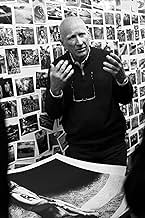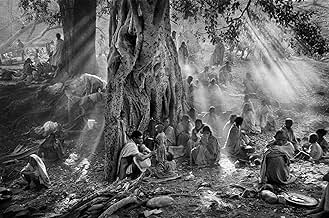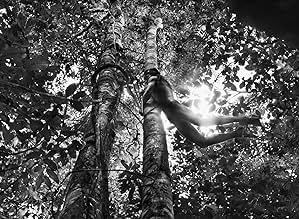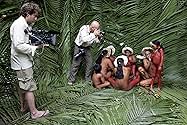VALUTAZIONE IMDb
8,4/10
24.736
LA TUA VALUTAZIONE
La vita e il lavoro del fotografo Sebastião Salgado, che ha passato quarant'anni a documentare società svantaggiate negli angoli nascosti del mondo.La vita e il lavoro del fotografo Sebastião Salgado, che ha passato quarant'anni a documentare società svantaggiate negli angoli nascosti del mondo.La vita e il lavoro del fotografo Sebastião Salgado, che ha passato quarant'anni a documentare società svantaggiate negli angoli nascosti del mondo.
- Regia
- Sceneggiatura
- Star
- Candidato a 1 Oscar
- 14 vittorie e 15 candidature totali
Recensioni in evidenza
A fascinating Wim Wenders documentary about Brazilian photographer, Sabastiao Salgado, detailing his life, and varied photographic projects from around the world. Wonderfully filmed, imaginatively edited.
Mainly known as a social photographer, Sabastiao Salgado has documented and revealed the horrors of war, famine and poverty. His travels around the world have accessed hidden brutalities and exposed injustices.
Perhaps as a respite from the human extremes he has witnessed he has recently moved on to projects about the environment. The film features many of his photos and numerous interviews with insights into his personal life.
Mainly known as a social photographer, Sabastiao Salgado has documented and revealed the horrors of war, famine and poverty. His travels around the world have accessed hidden brutalities and exposed injustices.
Perhaps as a respite from the human extremes he has witnessed he has recently moved on to projects about the environment. The film features many of his photos and numerous interviews with insights into his personal life.
It's a beautiful movie, though some parts were absolutely terrifying to watch.
There was no indication after watching several trailers of what lay ahead in terms of the suffering it very graphically depicted. It was almost about half the length of the film as well.
For most who are calloused, you will probably be fine. But be aware, those who are sensitive. It took me about 2 days to recover from the haunting images and pain they brought. I am glad I saw it though, because I received at least three wonderfully inspiring experiences from it:)
There was no indication after watching several trailers of what lay ahead in terms of the suffering it very graphically depicted. It was almost about half the length of the film as well.
For most who are calloused, you will probably be fine. But be aware, those who are sensitive. It took me about 2 days to recover from the haunting images and pain they brought. I am glad I saw it though, because I received at least three wonderfully inspiring experiences from it:)
THE SALT OF THE EARTH
A documentary on the photographer, Sebastiao Salgado's passion for exposing worlds that are hidden from our view as well as the undercurrents of man's greed, violence and inhumanity - all through what co-director Wim Wenders explains is the process of " drawing with light." The other director is Juliano Ribeiro Salgado, the photographer's son. For many years, I have been beguiled by Salgado's black and white imagery, particularly as source material and inspiration for many of my own late 1980s pastels. His representations are stark and at the same time filled with an expanse of tones - from the deep darkness of coal to the blinding whites which shine with the force of incorporeality; a range of imperceptibly varied grays sandwiched in-between - all breathtakingly beautiful and often reduced to abstract patternings which are in danger of overtaking his subjects, but Salgado is a master at balancing form and content.
I was particularly moved by his photographs of the fierce deprivation that droughts and famine had wreaked on Sub- Saharan Africa - particularly Ethiopia. Because Salgado exposed situations that many people were not aware of, his photos drilled a space for perception into our consciousness. Salgado has traveled to over 100 countries - projects often lasted years and the resulting books include OTHER AMERICAS, WORKERS, SAHEL - THE END OF THE ROAD, MIGRATIONS, Africa, and most recently GENESIS - the book that became his respite after years away from his native environs, witnessing the globe's devastation, including chronicling the genocide in Rawanda and the Congo. By the late 1990's he was heartbroken: "We humans are a terrible animal; we are extremely violent Our history is a history of war; it's an endless story My soul was sick I no longer believed in anything, in any salvation for the human species." (Quotes from Kenneth Turan's review in LA Times.)
THE SALT OF THE EARTH invites us to enter Salgado's personal sphere; we meet his beloved wife Leila, the enduring relationship of his life, the editor of his photographs; the mother of Juliano and Rodrigo - the youngest born with Down syndrome; the compassion and love that unites the entire family in their own personal struggles with domesticity, and the enormous achievement of reclaiming the cattle ranch that was once Salgado's home near the town of Aimores in Brazil's state of Minas Gerais. Memories of the fecund greenery and waterfalls were incised into Sebastiao's childhood recollections and when he returned in the 1990's his homeland was an environmental disaster - dry and parched.
Salgado, his spirit quenched by regarding the pillage, and spoliation around the universe was re-invigorated by Leila's dream of planting a forest in Brazil starting with a few trees and "returning the property to its natural state of subtropical rainforest and in April 1998 they founded the Instituto Terra, an environmental organization which has now been declared a Private Natural Heritage Reserve, some 17,000 acres of deforested and badly eroded land have undergone a remarkable metamorphosis More than four million seedlings native to Brazil's Atlantic Forest have been raised in the institute's own nursery " * This resuscitation propelled Salgado to travel again focusing on the beauties of the planet, resulting in his latest book GENESIS. ( *About us -The Instituto Terra.) http://bit.ly/1JQQzvd
The documentary uses Salgado's majestic photographs interspersing them with site visits to previously unrecorded locations, including old color footage; using his voice and conversations to great effect. We get a sense of the quiet strength of this man, his commitment to justice and the deep suffering that his vision extracts with the lens of a camera. The plethora of interchangeable living beings moving about silhouetted against the background of clouds billowing in the infinite skies, underscore the brevity of time and existence. We are only here for a short interval and Salgado's output is a plea for respect, justice and accommodation among the men/women/animals and the frangible cosmos we all inhabit.
A documentary on the photographer, Sebastiao Salgado's passion for exposing worlds that are hidden from our view as well as the undercurrents of man's greed, violence and inhumanity - all through what co-director Wim Wenders explains is the process of " drawing with light." The other director is Juliano Ribeiro Salgado, the photographer's son. For many years, I have been beguiled by Salgado's black and white imagery, particularly as source material and inspiration for many of my own late 1980s pastels. His representations are stark and at the same time filled with an expanse of tones - from the deep darkness of coal to the blinding whites which shine with the force of incorporeality; a range of imperceptibly varied grays sandwiched in-between - all breathtakingly beautiful and often reduced to abstract patternings which are in danger of overtaking his subjects, but Salgado is a master at balancing form and content.
I was particularly moved by his photographs of the fierce deprivation that droughts and famine had wreaked on Sub- Saharan Africa - particularly Ethiopia. Because Salgado exposed situations that many people were not aware of, his photos drilled a space for perception into our consciousness. Salgado has traveled to over 100 countries - projects often lasted years and the resulting books include OTHER AMERICAS, WORKERS, SAHEL - THE END OF THE ROAD, MIGRATIONS, Africa, and most recently GENESIS - the book that became his respite after years away from his native environs, witnessing the globe's devastation, including chronicling the genocide in Rawanda and the Congo. By the late 1990's he was heartbroken: "We humans are a terrible animal; we are extremely violent Our history is a history of war; it's an endless story My soul was sick I no longer believed in anything, in any salvation for the human species." (Quotes from Kenneth Turan's review in LA Times.)
THE SALT OF THE EARTH invites us to enter Salgado's personal sphere; we meet his beloved wife Leila, the enduring relationship of his life, the editor of his photographs; the mother of Juliano and Rodrigo - the youngest born with Down syndrome; the compassion and love that unites the entire family in their own personal struggles with domesticity, and the enormous achievement of reclaiming the cattle ranch that was once Salgado's home near the town of Aimores in Brazil's state of Minas Gerais. Memories of the fecund greenery and waterfalls were incised into Sebastiao's childhood recollections and when he returned in the 1990's his homeland was an environmental disaster - dry and parched.
Salgado, his spirit quenched by regarding the pillage, and spoliation around the universe was re-invigorated by Leila's dream of planting a forest in Brazil starting with a few trees and "returning the property to its natural state of subtropical rainforest and in April 1998 they founded the Instituto Terra, an environmental organization which has now been declared a Private Natural Heritage Reserve, some 17,000 acres of deforested and badly eroded land have undergone a remarkable metamorphosis More than four million seedlings native to Brazil's Atlantic Forest have been raised in the institute's own nursery " * This resuscitation propelled Salgado to travel again focusing on the beauties of the planet, resulting in his latest book GENESIS. ( *About us -The Instituto Terra.) http://bit.ly/1JQQzvd
The documentary uses Salgado's majestic photographs interspersing them with site visits to previously unrecorded locations, including old color footage; using his voice and conversations to great effect. We get a sense of the quiet strength of this man, his commitment to justice and the deep suffering that his vision extracts with the lens of a camera. The plethora of interchangeable living beings moving about silhouetted against the background of clouds billowing in the infinite skies, underscore the brevity of time and existence. We are only here for a short interval and Salgado's output is a plea for respect, justice and accommodation among the men/women/animals and the frangible cosmos we all inhabit.
Very touching and beautiful doc about life, love, loss, despair, redemption and it shows how, by sheer faith, you can build a forest. Literally. The beautiful photos tell a troubling yet touching story that will make you angry at mankind. By the end you will find yourself believing again and hoping that one day you could be so humble as to reflect on the negative influences in your life and thus be able to change those nativities into positive reactions . You are probably not doing enough for the world around you and when you see how easy it is to make real change, hopefully it will be a call to action. If a picture tells 1000 words, then this film tells 1000 stories.
10Iwould
Wim Wenders being Wim Wenders, he has nothing left to prove about movie making. So most of this documentary is simply made by the pictures of Sebastião Salgado, and by close-ups of his face: he is looking at the images (but through the screen at the same time), while telling and explaining to the audience the genesis and the reasons of his work. It is very simple, yes, but at the same time it's extremely powerful. So powerful that, after a while, I was under the impression that those still b/w images were alive: crowds in the mass scenes seemed to move, people in portraits looked like they were going to turn their heads, and talk.
This movie should be shown in schools. The work of Salgado has testified some of the major (but lesser known) disasters of recent world history, none of which came within ear of the western world - much more interested in the brilliant lives of the fashion victims than in the tragic fate of the casualties of famines and wars.
Nietzsche famously once wrote: "When you look into the abyss, the abyss also looks into you". Salgado had the guts to stare to the abyss, without blinking - but clicking. He did it to give to others the opportunity to know, and possibly to better understand the meaning of the term "humanity". Some of Sebastião Salgado images are horrible, but it is by far more horrible to think that without him those horrors would have happened with nobody to remember about them. His work creates grounds for memory, and memory grows some chances for hope, and hope give us and some reason to believe in a better future for our troubled planet.
This movie should be shown in schools. The work of Salgado has testified some of the major (but lesser known) disasters of recent world history, none of which came within ear of the western world - much more interested in the brilliant lives of the fashion victims than in the tragic fate of the casualties of famines and wars.
Nietzsche famously once wrote: "When you look into the abyss, the abyss also looks into you". Salgado had the guts to stare to the abyss, without blinking - but clicking. He did it to give to others the opportunity to know, and possibly to better understand the meaning of the term "humanity". Some of Sebastião Salgado images are horrible, but it is by far more horrible to think that without him those horrors would have happened with nobody to remember about them. His work creates grounds for memory, and memory grows some chances for hope, and hope give us and some reason to believe in a better future for our troubled planet.
Lo sapevi?
- QuizThe title of the film is a biblical reference, Matthew 5:13: 'You are the salt of the earth. But if the salt loses its saltiness, how can it be made salty again? It is no longer good for anything, except to be thrown out and trampled underfoot.'
- Citazioni
Sebastião Salgado - Photographer: We are a ferocious animal. We humans are terrible animals. Our history is a history of wars. It's an endless story, a tale of madness.
- ConnessioniFeatured in The Oscars (2015)
- Colonne sonoreThe Salt of the Earth
Written by Laurent Petitgand
Performed by Laurent Petitgand
I più visti
Accedi per valutare e creare un elenco di titoli salvati per ottenere consigli personalizzati
- How long is The Salt of the Earth?Powered by Alexa
Dettagli
- Data di uscita
- Paesi di origine
- Sito ufficiale
- Lingue
- Celebre anche come
- La sal de la Tierra
- Luoghi delle riprese
- Yalimo, Papua, Indonesia(Yali tribe)
- Aziende produttrici
- Vedi altri crediti dell’azienda su IMDbPro
Botteghino
- Lordo Stati Uniti e Canada
- 1.343.349 USD
- Fine settimana di apertura Stati Uniti e Canada
- 44.900 USD
- 29 mar 2015
- Lordo in tutto il mondo
- 5.961.567 USD
- Tempo di esecuzione
- 1h 50min(110 min)
- Colore
- Mix di suoni
- Proporzioni
- 1.85 : 1
Contribuisci a questa pagina
Suggerisci una modifica o aggiungi i contenuti mancanti

![Guarda Bande-annonce [OV]](https://m.media-amazon.com/images/M/MV5BMTY0M2ZjMzYtZmJiZC00MDRlLTljNWMtMDRiNmQ1YTgwM2EyXkEyXkFqcGdeQXRyYW5zY29kZS13b3JrZmxvdw@@._V1_QL75_UX500_CR0)














